Cuộc cách mạng công nghiệp 4.0 với phát triển nhân lực nông nghiệp công nghệ cao tỉnh Thái Nguyên
Phát triển ngành nông nghiệp công nghệ cao là xu thế tất yếu của sản xuất nông nghiệp Việt Nam
nói chung và của tỉnh Thái Nguyên nói riêng. Thái Nguyên là tỉnh trung tâm của vùng Trung du và
Miền núi phía Bắc, có điều kiện tự nhiên và tài nguyên thiên nhiên phong phú để phát triển kinh
tế, đặc biệt là phát triển ngành nông nghiệp. Tuy nhiên, để ngành này phát triển bền vững, ngoài
tiến bộ khoa học công nghệ thì nguồn nhân lực đủ khả năng ứng dụng thành tựu khoa học công
nghệ vào sản xuất nông nghiệp là một yếu tố quan trọng. Bài viết đánh giá chung về thực trạng
nguồn nhân lực ở Thái Nguyên và đề xuất một số giải pháp để tăng số lượng và nâng cao chất
lượng nguồn nhân lực hướng tới phát triển nông nghiệp công nghệ cao.
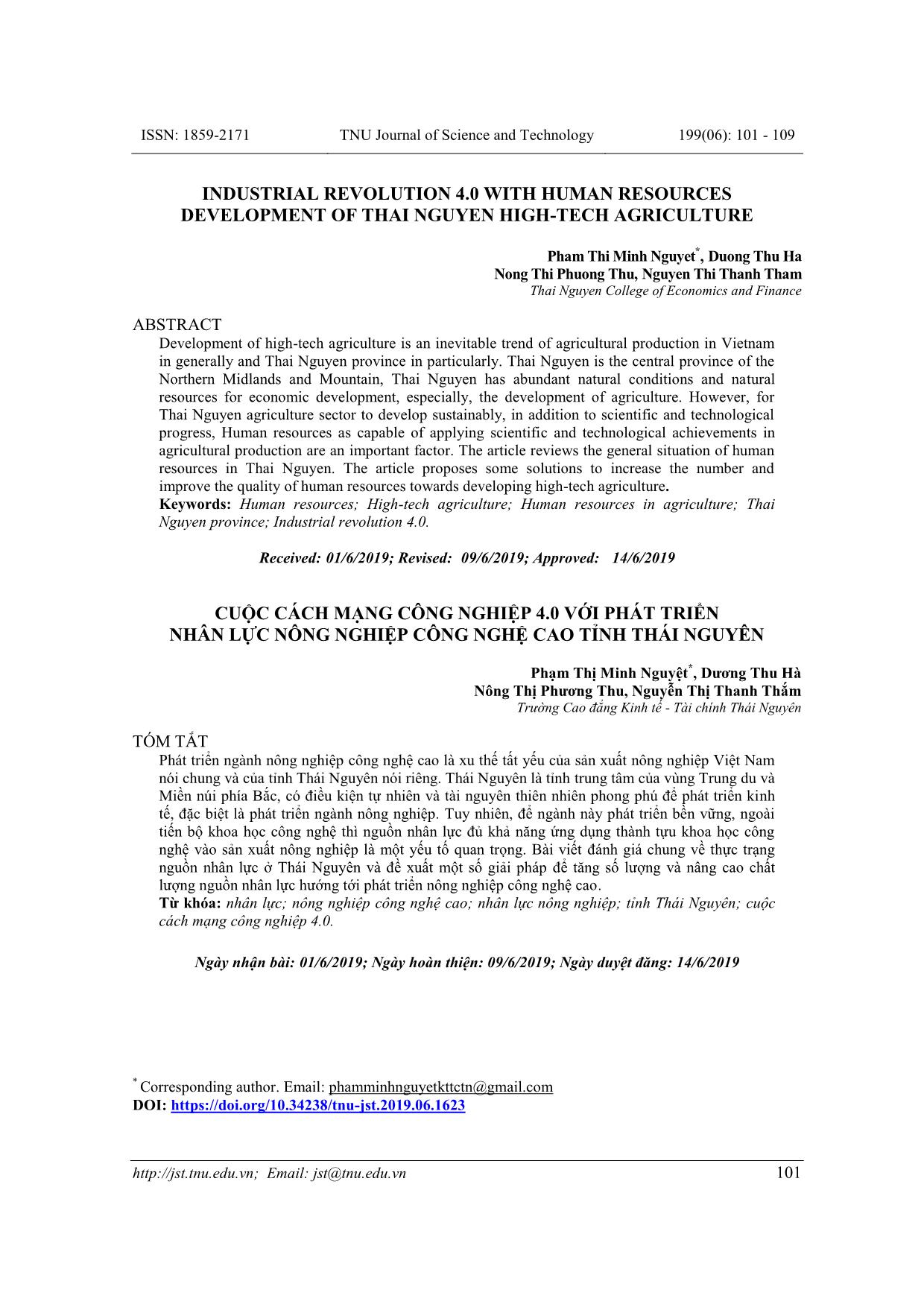
Trang 1
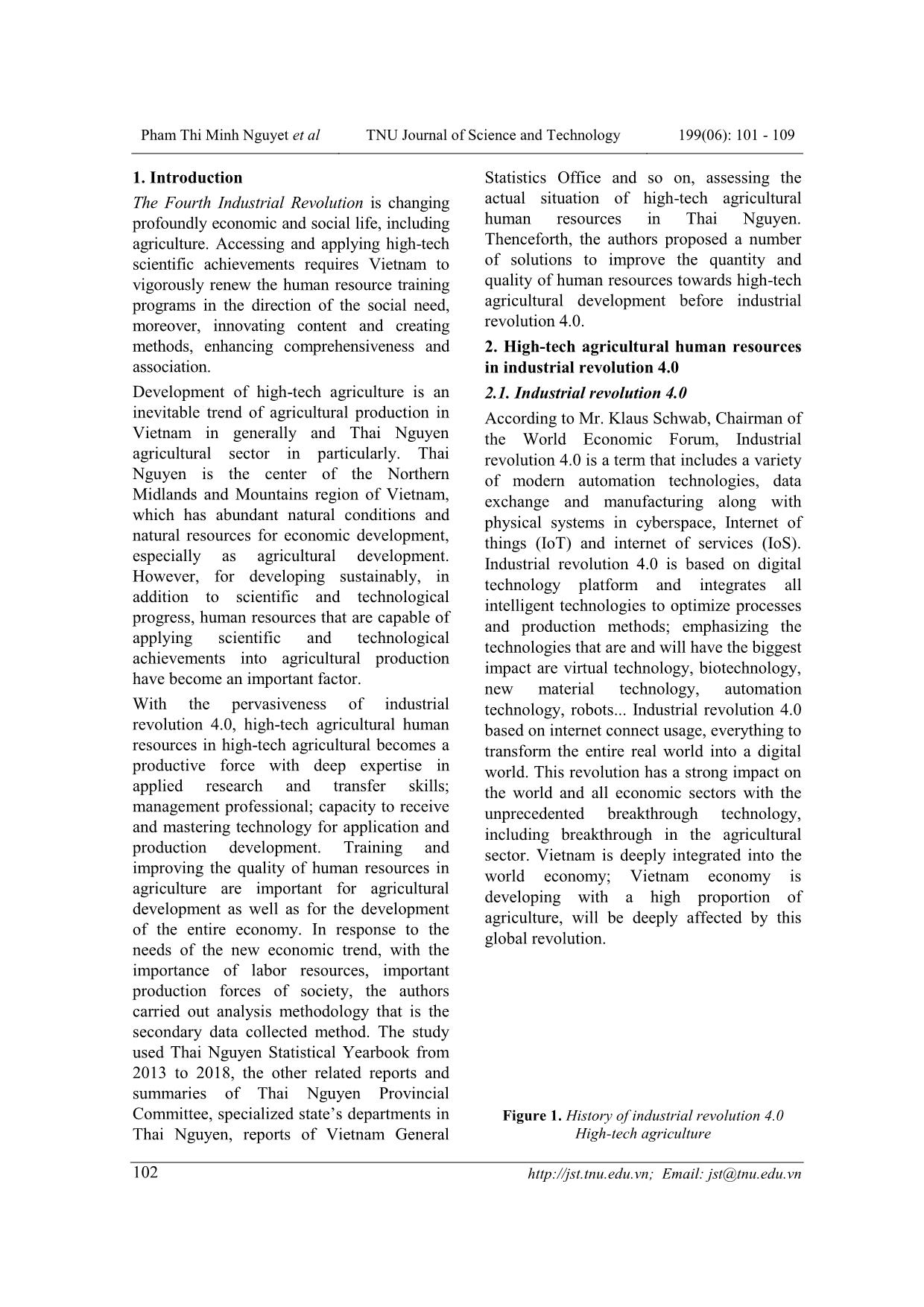
Trang 2
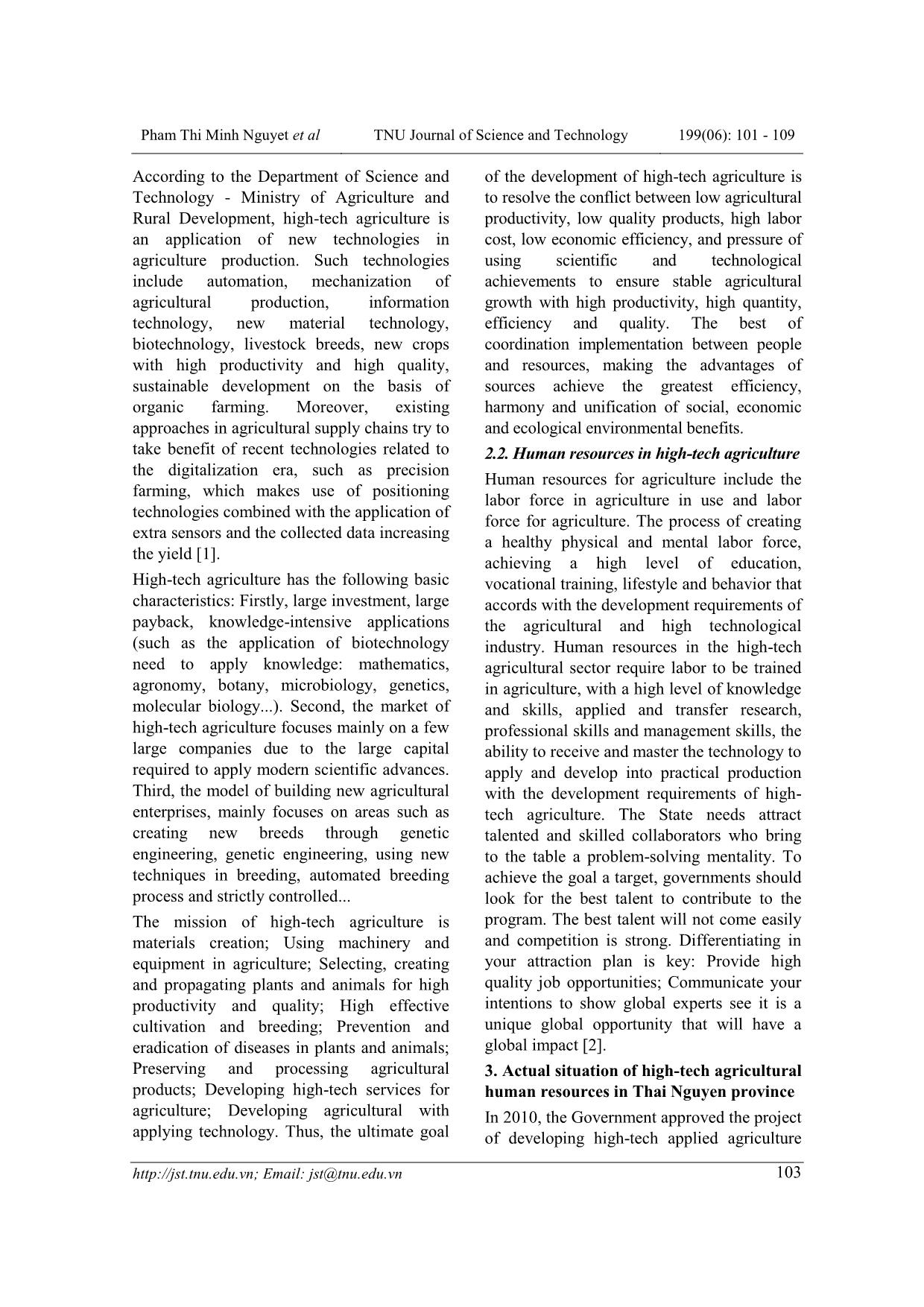
Trang 3
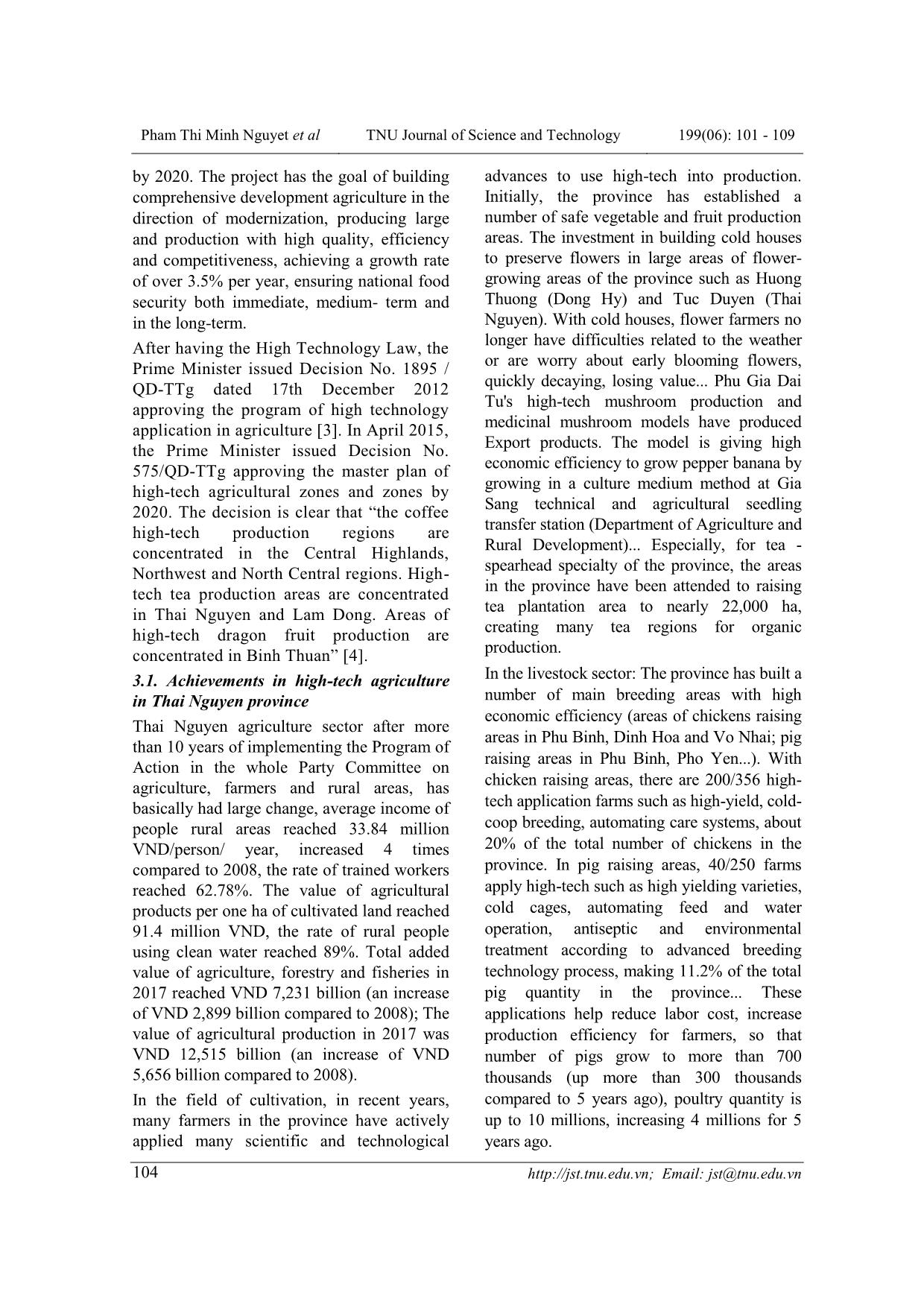
Trang 4
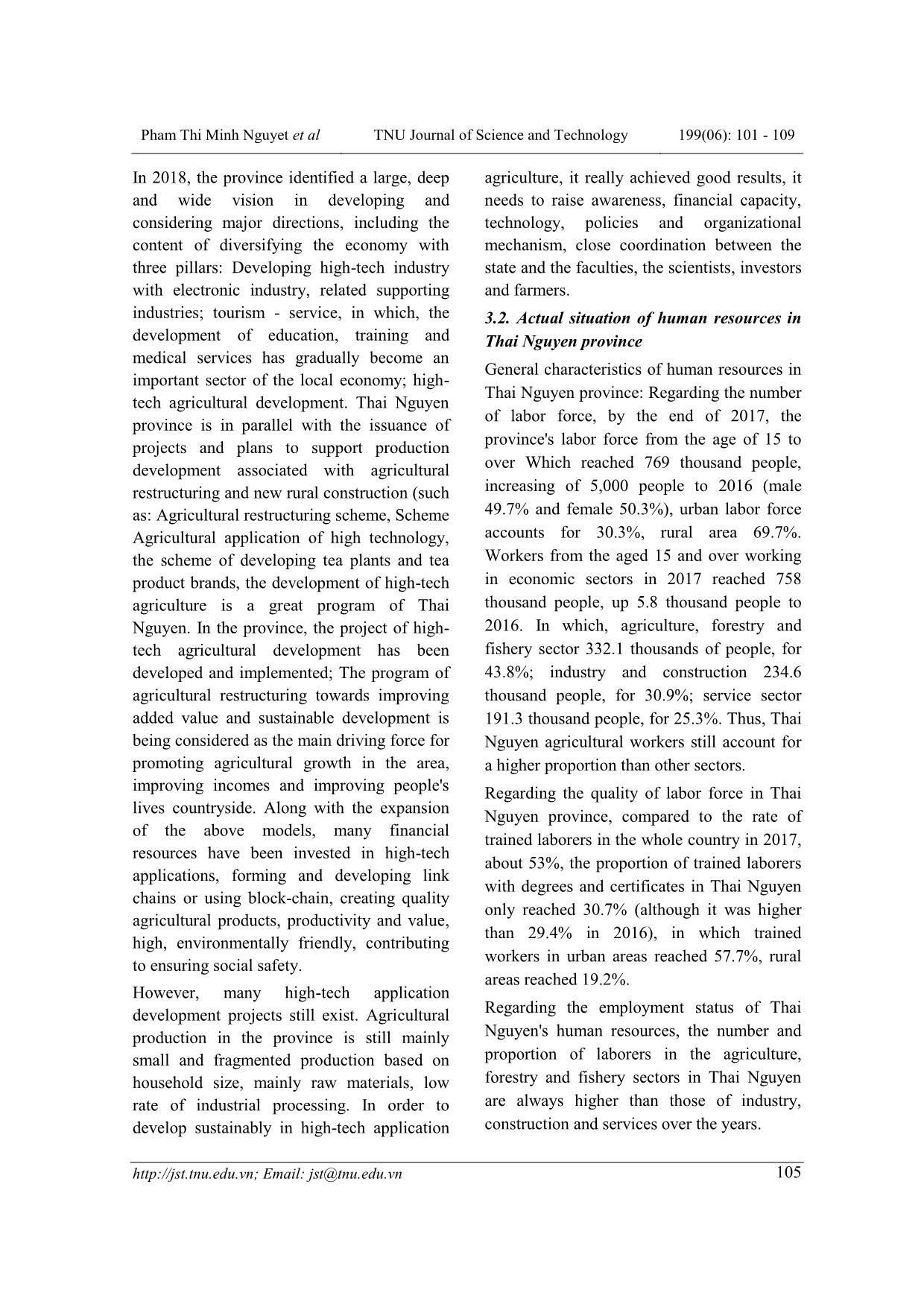
Trang 5
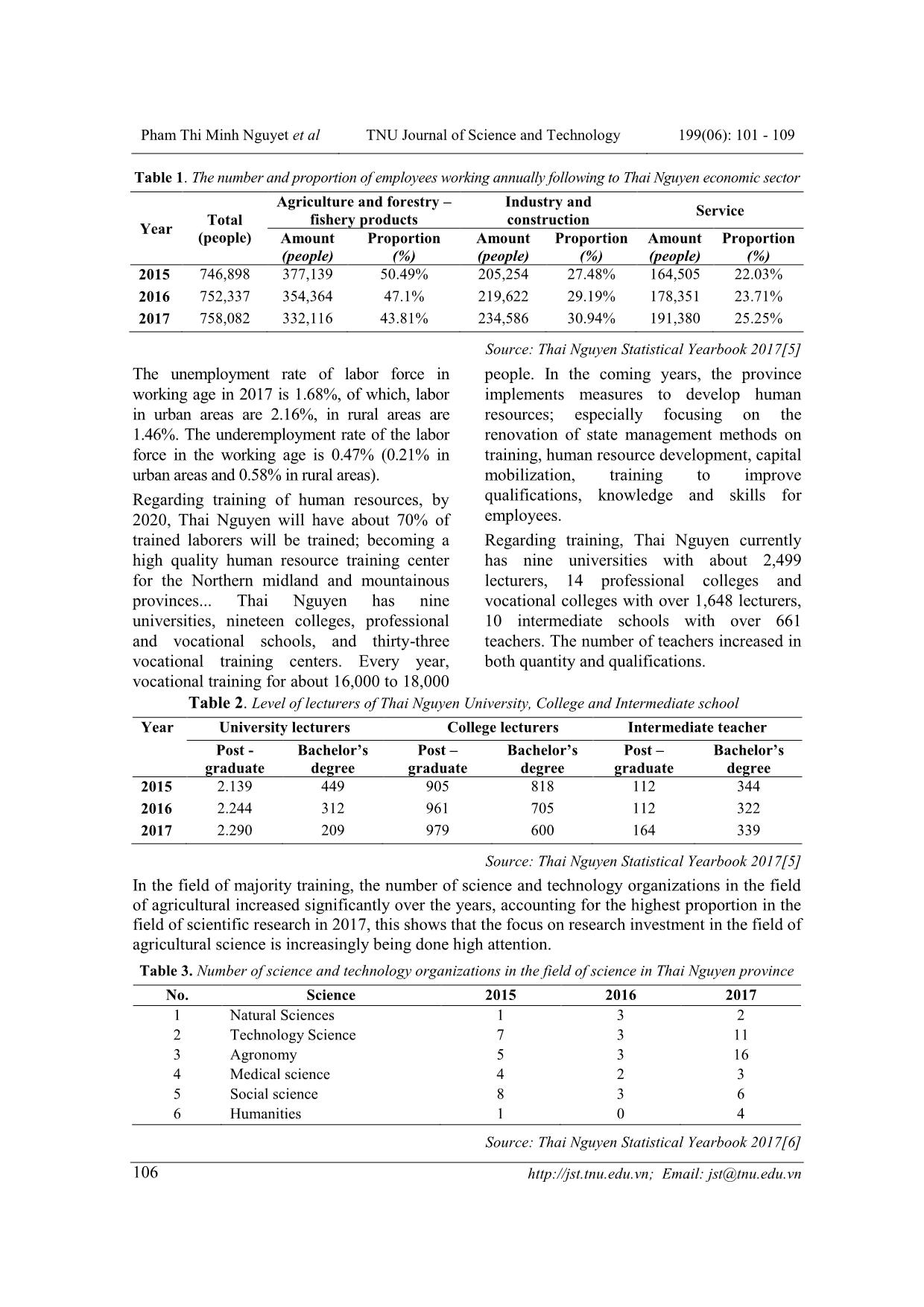
Trang 6
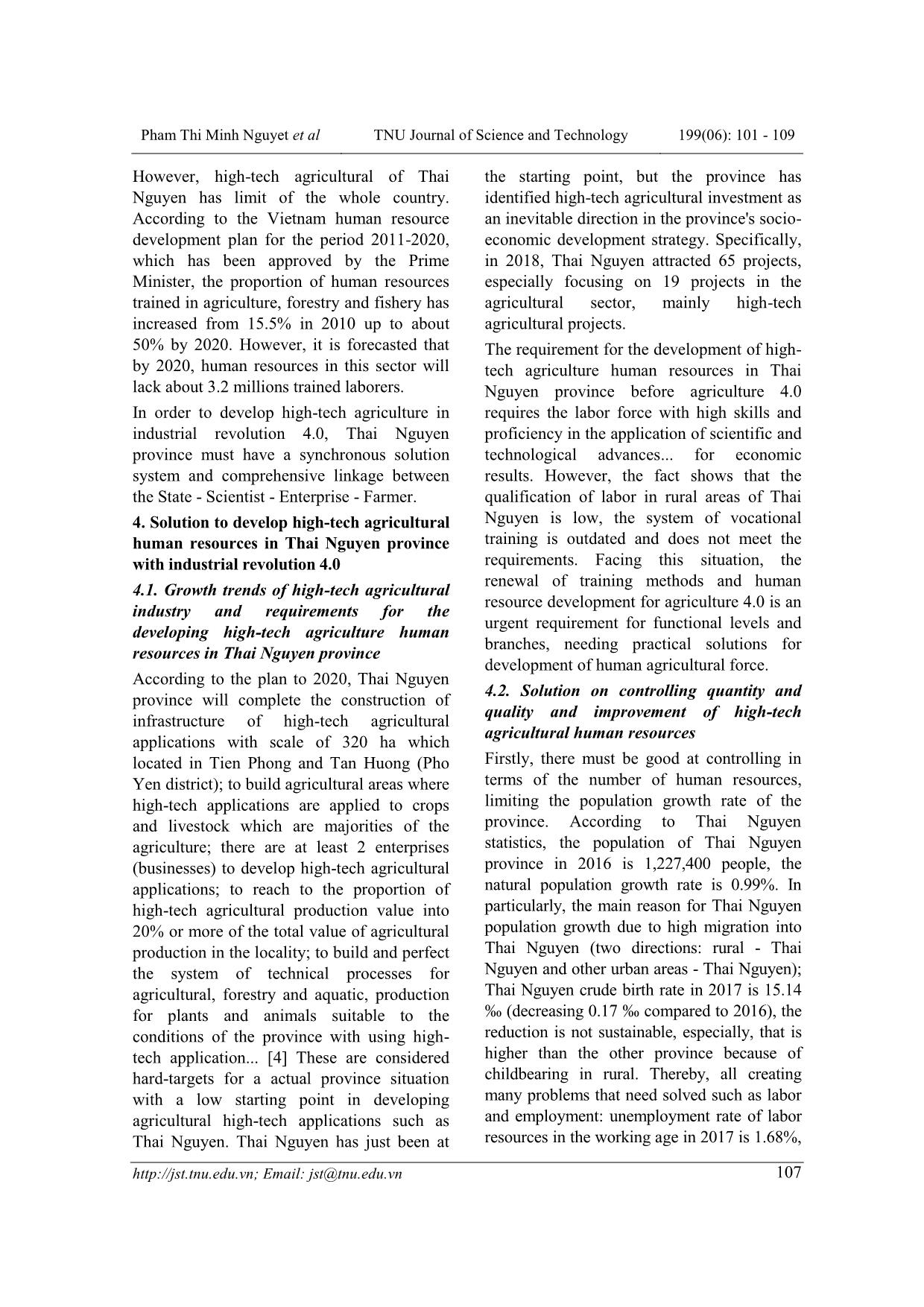
Trang 7
Tóm tắt nội dung tài liệu: Cuộc cách mạng công nghiệp 4.0 với phát triển nhân lực nông nghiệp công nghệ cao tỉnh Thái Nguyên
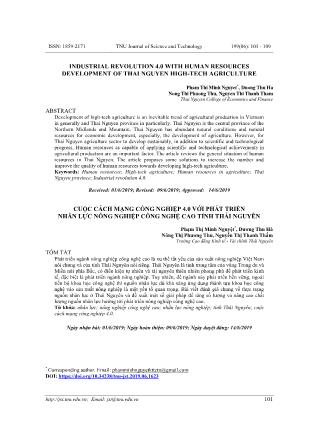
ar, ensuring national food security both immediate, medium- term and in the long-term. After having the High Technology Law, the Prime Minister issued Decision No. 1895 / QD-TTg dated 17th December 2012 approving the program of high technology application in agriculture [3]. In April 2015, the Prime Minister issued Decision No. 575/QD-TTg approving the master plan of high-tech agricultural zones and zones by 2020. The decision is clear that “the coffee high-tech production regions are concentrated in the Central Highlands, Northwest and North Central regions. High- tech tea production areas are concentrated in Thai Nguyen and Lam Dong. Areas of high-tech dragon fruit production are concentrated in Binh Thuan” [4]. 3.1. Achievements in high-tech agriculture in Thai Nguyen province Thai Nguyen agriculture sector after more than 10 years of implementing the Program of Action in the whole Party Committee on agriculture, farmers and rural areas, has basically had large change, average income of people rural areas reached 33.84 million VND/person/ year, increased 4 times compared to 2008, the rate of trained workers reached 62.78%. The value of agricultural products per one ha of cultivated land reached 91.4 million VND, the rate of rural people using clean water reached 89%. Total added value of agriculture, forestry and fisheries in 2017 reached VND 7,231 billion (an increase of VND 2,899 billion compared to 2008); The value of agricultural production in 2017 was VND 12,515 billion (an increase of VND 5,656 billion compared to 2008). In the field of cultivation, in recent years, many farmers in the province have actively applied many scientific and technological advances to use high-tech into production. Initially, the province has established a number of safe vegetable and fruit production areas. The investment in building cold houses to preserve flowers in large areas of flower- growing areas of the province such as Huong Thuong (Dong Hy) and Tuc Duyen (Thai Nguyen). With cold houses, flower farmers no longer have difficulties related to the weather or are worry about early blooming flowers, quickly decaying, losing value... Phu Gia Dai Tu's high-tech mushroom production and medicinal mushroom models have produced Export products. The model is giving high economic efficiency to grow pepper banana by growing in a culture medium method at Gia Sang technical and agricultural seedling transfer station (Department of Agriculture and Rural Development)... Especially, for tea - spearhead specialty of the province, the areas in the province have been attended to raising tea plantation area to nearly 22,000 ha, creating many tea regions for organic production. In the livestock sector: The province has built a number of main breeding areas with high economic efficiency (areas of chickens raising areas in Phu Binh, Dinh Hoa and Vo Nhai; pig raising areas in Phu Binh, Pho Yen...). With chicken raising areas, there are 200/356 high- tech application farms such as high-yield, cold- coop breeding, automating care systems, about 20% of the total number of chickens in the province. In pig raising areas, 40/250 farms apply high-tech such as high yielding varieties, cold cages, automating feed and water operation, antiseptic and environmental treatment according to advanced breeding technology process, making 11.2% of the total pig quantity in the province... These applications help reduce labor cost, increase production efficiency for farmers, so that number of pigs grow to more than 700 thousands (up more than 300 thousands compared to 5 years ago), poultry quantity is up to 10 millions, increasing 4 millions for 5 years ago. Pham Thi Minh Nguyet et al TNU Journal of Science and Technology 199(06): 101 - 109 Email: jst@tnu.edu.vn 105 In 2018, the province identified a large, deep and wide vision in developing and considering major directions, including the content of diversifying the economy with three pillars: Developing high-tech industry with electronic industry, related supporting industries; tourism - service, in which, the development of education, training and medical services has gradually become an important sector of the local economy; high- tech agricultural development. Thai Nguyen province is in parallel with the issuance of projects and plans to support production development associated with agricultural restructuring and new rural construction (such as: Agricultural restructuring scheme, Scheme Agricultural application of high technology, the scheme of developing tea plants and tea product brands, the development of high-tech agriculture is a great program of Thai Nguyen. In the province, the project of high- tech agricultural development has been developed and implemented; The program of agricultural restructuring towards improving added value and sustainable development is being considered as the main driving force for promoting agricultural growth in the area, improving incomes and improving people's lives countryside. Along with the expansion of the above models, many financial resources have been invested in high-tech applications, forming and developing link chains or using block-chain, creating quality agricultural products, productivity and value, high, environmentally friendly, contributing to ensuring social safety. However, many high-tech application development projects still exist. Agricultural production in the province is still mainly small and fragmented production based on household size, mainly raw materials, low rate of industrial processing. In order to develop sustainably in high-tech application agriculture, it really achieved good results, it needs to raise awareness, financial capacity, technology, policies and organizational mechanism, close coordination between the state and the faculties, the scientists, investors and farmers. 3.2. Actual situation of human resources in Thai Nguyen province General characteristics of human resources in Thai Nguyen province: Regarding the number of labor force, by the end of 2017, the province's labor force from the age of 15 to over Which reached 769 thousand people, increasing of 5,000 people to 2016 (male 49.7% and female 50.3%), urban labor force accounts for 30.3%, rural area 69.7%. Workers from the aged 15 and over working in economic sectors in 2017 reached 758 thousand people, up 5.8 thousand people to 2016. In which, agriculture, forestry and fishery sector 332.1 thousands of people, for 43.8%; industry and construction 234.6 thousand people, for 30.9%; service sector 191.3 thousand people, for 25.3%. Thus, Thai Nguyen agricultural workers still account for a higher proportion than other sectors. Regarding the quality of labor force in Thai Nguyen province, compared to the rate of trained laborers in the whole country in 2017, about 53%, the proportion of trained laborers with degrees and certificates in Thai Nguyen only reached 30.7% (although it was higher than 29.4% in 2016), in which trained workers in urban areas reached 57.7%, rural areas reached 19.2%. Regarding the employment status of Thai Nguyen's human resources, the number and proportion of laborers in the agriculture, forestry and fishery sectors in Thai Nguyen are always higher than those of industry, construction and services over the years. Pham Thi Minh Nguyet et al TNU Journal of Science and Technology 199(06): 101 - 109 Email: jst@tnu.edu.vn 106 Table 1. The number and proportion of employees working annually following to Thai Nguyen economic sector Year Total (people) Agriculture and forestry – fishery products Industry and construction Service Amount (people) Proportion (%) Amount (people) Proportion (%) Amount (people) Proportion (%) 2015 746,898 377,139 50.49% 205,254 27.48% 164,505 22.03% 2016 752,337 354,364 47.1% 219,622 29.19% 178,351 23.71% 2017 758,082 332,116 43.81% 234,586 30.94% 191,380 25.25% Source: Thai Nguyen Statistical Yearbook 2017[5] The unemployment rate of labor force in working age in 2017 is 1.68%, of which, labor in urban areas are 2.16%, in rural areas are 1.46%. The underemployment rate of the labor force in the working age is 0.47% (0.21% in urban areas and 0.58% in rural areas). Regarding training of human resources, by 2020, Thai Nguyen will have about 70% of trained laborers will be trained; becoming a high quality human resource training center for the Northern midland and mountainous provinces... Thai Nguyen has nine universities, nineteen colleges, professional and vocational schools, and thirty-three vocational training centers. Every year, vocational training for about 16,000 to 18,000 people. In the coming years, the province implements measures to develop human resources; especially focusing on the renovation of state management methods on training, human resource development, capital mobilization, training to improve qualifications, knowledge and skills for employees. Regarding training, Thai Nguyen currently has nine universities with about 2,499 lecturers, 14 professional colleges and vocational colleges with over 1,648 lecturers, 10 intermediate schools with over 661 teachers. The number of teachers increased in both quantity and qualifications. Table 2. Level of lecturers of Thai Nguyen University, College and Intermediate school Year University lecturers College lecturers Intermediate teacher Post - graduate Bachelor’s degree Post – graduate Bachelor’s degree Post – graduate Bachelor’s degree 2015 2.139 449 905 818 112 344 2016 2.244 312 961 705 112 322 2017 2.290 209 979 600 164 339 Source: Thai Nguyen Statistical Yearbook 2017[5] In the field of majority training, the number of science and technology organizations in the field of agricultural increased significantly over the years, accounting for the highest proportion in the field of scientific research in 2017, this shows that the focus on research investment in the field of agricultural science is increasingly being done high attention. Table 3. Number of science and technology organizations in the field of science in Thai Nguyen province No. Science 2015 2016 2017 1 Natural Sciences 1 3 2 2 Technology Science 7 3 11 3 Agronomy 5 3 16 4 Medical science 4 2 3 5 Social science 8 3 6 6 Humanities 1 0 4 Source: Thai Nguyen Statistical Yearbook 2017[6] Pham Thi Minh Nguyet et al TNU Journal of Science and Technology 199(06): 101 - 109 Email: jst@tnu.edu.vn 107 However, high-tech agricultural of Thai Nguyen has limit of the whole country. According to the Vietnam human resource development plan for the period 2011-2020, which has been approved by the Prime Minister, the proportion of human resources trained in agriculture, forestry and fishery has increased from 15.5% in 2010 up to about 50% by 2020. However, it is forecasted that by 2020, human resources in this sector will lack about 3.2 millions trained laborers. In order to develop high-tech agriculture in industrial revolution 4.0, Thai Nguyen province must have a synchronous solution system and comprehensive linkage between the State - Scientist - Enterprise - Farmer. 4. Solution to develop high-tech agricultural human resources in Thai Nguyen province with industrial revolution 4.0 4.1. Growth trends of high-tech agricultural industry and requirements for the developing high-tech agriculture human resources in Thai Nguyen province According to the plan to 2020, Thai Nguyen province will complete the construction of infrastructure of high-tech agricultural applications with scale of 320 ha which located in Tien Phong and Tan Huong (Pho Yen district); to build agricultural areas where high-tech applications are applied to crops and livestock which are majorities of the agriculture; there are at least 2 enterprises (businesses) to develop high-tech agricultural applications; to reach to the proportion of high-tech agricultural production value into 20% or more of the total value of agricultural production in the locality; to build and perfect the system of technical processes for agricultural, forestry and aquatic, production for plants and animals suitable to the conditions of the province with using high- tech application... [4] These are considered hard-targets for a actual province situation with a low starting point in developing agricultural high-tech applications such as Thai Nguyen. Thai Nguyen has just been at the starting point, but the province has identified high-tech agricultural investment as an inevitable direction in the province's socio- economic development strategy. Specifically, in 2018, Thai Nguyen attracted 65 projects, especially focusing on 19 projects in the agricultural sector, mainly high-tech agricultural projects. The requirement for the development of high- tech agriculture human resources in Thai Nguyen province before agriculture 4.0 requires the labor force with high skills and proficiency in the application of scientific and technological advances... for economic results. However, the fact shows that the qualification of labor in rural areas of Thai Nguyen is low, the system of vocational training is outdated and does not meet the requirements. Facing this situation, the renewal of training methods and human resource development for agriculture 4.0 is an urgent requirement for functional levels and branches, needing practical solutions for development of human agricultural force. 4.2. Solution on controlling quantity and quality and improvement of high-tech agricultural human resources Firstly, there must be good at controlling in terms of the number of human resources, limiting the population growth rate of the province. According to Thai Nguyen statistics, the population of Thai Nguyen province in 2016 is 1,227,400 people, the natural population growth rate is 0.99%. In particularly, the main reason for Thai Nguyen population growth due to high migration into Thai Nguyen (two directions: rural - Thai Nguyen and other urban areas - Thai Nguyen); Thai Nguyen crude birth rate in 2017 is 15.14 ‰ (decreasing 0.17 ‰ compared to 2016), the reduction is not sustainable, especially, that is higher than the other province because of childbearing in rural. Thereby, all creating many problems that need solved such as labor and employment: unemployment rate of labor resources in the working age in 2017 is 1.68%,
File đính kèm:
 cuoc_cach_mang_cong_nghiep_4_0_voi_phat_trien_nhan_luc_nong.pdf
cuoc_cach_mang_cong_nghiep_4_0_voi_phat_trien_nhan_luc_nong.pdf

